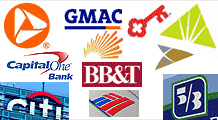Capital race is on for banks
Wells Fargo and Morgan Stanley are finding stock sales to be a breeze. Those banks that wait, however, may find themselves in a more difficult spot.
NEW YORK (CNNMoney.com) -- The race to raise capital among banks has begun.
In the wake of the federal government's warning that the nation's largest financial institutions face an estimated $75 billion capital shortfall, banks are already scrambling to raise the necessary funds to keep regulators happy.
Some financial institutions, namely Morgan Stanley (MS, Fortune 500) and Wells Fargo (WFC, Fortune 500), hardly gave investors a chance to digest Thursday's results from the government's two-month-long "stress test" program before revealing plans to raise capital through the sale of common stock. Both firms quickly followed that up by pricing their offerings on Friday.
And there are signs that other leading institutions are already looking to follow suit.
Bank of America (BAC, Fortune 500), whose nearly $34 billion capital shortfall eclipsed that of any of the other 19 institutions tested, registered Friday to sell 1.25 billion shares, which the company estimates will raise nearly $11 billion. In a conference call with investors late Thursday, executives at the Charlotte, N.C.-based lender indicated that they planned to raise much of the $34 billion through new stock issuance.
Cleveland-based KeyCorp (KEY, Fortune 500) also unveiled plans Monday to offer up to $750 million in common stock, in sales from time to time, in order to fix its $1.8 billion capital shortfall.
And even those institutions that managed to ace their test are piling into the public markets, hoping to harness investors' newfound interest in bank stocks.
A trio of lenders including U.S. Bancorp (USB, Fortune 500), Capital One (COF, Fortune 500) and the Winston-Salem, N.C.-based BB&T (BBT, Fortune 500) all announced plans before Monday's opening bell to issue stock, saying they planned to use the proceeds to repay the preferred stock and warrants associated with the government's Troubled Asset Relief Program, or TARP.
As recently as a month ago, investors would have scoffed at the notion of a bank successfully issuing stock, given the variety of threats facing the industry. There were, of course, ongoing fears about the underlying assets of many U.S. financial institutions and the impact of the quickly sinking economy, as well as concerns about how much of the government's preferred stakes in various banks might be converted into common stock, which would effectively dilute existing shareholders.
Thursday's release of the official results of the government's stress-test program helped silence many of those fears, says Samuel Hayes, professor emeritus of investment banking at Harvard Business School.
Even as regulators estimated that losses for the group could reach $599 billion under a severe economic scenario, all of the 19 tested were deemed solvent and well-capitalized.
"Now that these issues have been settled, there is considerable interest by investors in establishing a position they don't have or increasing their position in those banks that are going to be the dominant forces," Hayes said.
Renewed interest in U.S. financial institutions is hardly novel, as subsiding fears over the sector have made investors increasingly bullish on banks over the last two months. Since the end of March, the S&P Banking index, one of the closely watched gauges of the industry, is up 49%.
Without that recent run-up, many experts wonder whether banks would have been able to raise as much capital as they did. With both of their offerings oversubscribed, Morgan Stanley and Wells Fargo raised billions of dollars more than they had originally anticipated as part of Friday's stock sale.
Helping to grease the wheels was the fact that both firms issued shares at an 11% discount to where their stock ended in the previous session - a trend that may persist to keep investor interest in banks piqued, according to experts.
Of course, those institutions deemed in need by regulators as a result of the stress tests do not have to solely rely on stock sales. Banks may opt to raise capital by selling loans or securities through the government's Public-Private Investment Program (PPIP), entering joint ventures or selling business lines altogether. Bank of America said Thursday that it is actively shopping both its First Republic Bank and Columbia Management divisions.
If a bank is unable to raise capital on its own, it will have to turn to regulators for assistance, which many anticipate would mean converting the government's preferred stake into common stock.
"I'm not expecting a major problem for most banks in getting the [private] capital they need," said Fox-Pitt Kelton analyst Albert Savastano.
But with so many lenders rushing to issue stock all at once, there are those analysts who fear that banks that dither about their plans, including some of the regional lenders included in the test, may find investors quickly satiated.
Then again, it might just take one terrible quarterly performance or another painful turn in the economy for investors to sour again on the nation's banking industry.
"Those may be a harder sale," said Ben Holmes, head of Colorado-based research firm Morningnotes.com, which tracks both initial and secondary public offerings. ![]()


